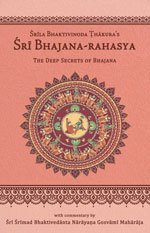Bhajana-Rahasya
by Srila Bhaktivinoda Thakura Mahasaya | 2010 | 123,965 words
The Bhajana-rahasya Text 14, English translation, including commentary (vritti). The Bhajana-rahasya is a compilation of verses describing the mercy of the eight pairs of names (Yugala-nama) of the Maha-mantra. This is text 14 belonging to the chapter “Dvitiya-yama-sadhana (Pratah-kaliya-bhajana)” representing the first six dandas of the morning: approximately 6.00 a.m.–8.30 a.m.
Text 14
The characteristics of bhakti-yoga are described in Śrīmad-Bhāgavatam (1.2.12, 7):
तच् छ्रद्दधाना मुनयो ज्ञान-वैराग्य-युक्तया
पश्यन्त्य् आत्मनि चात्मानं भक्त्या श्रुत-गृहीतया
वासुदेवे भगवति भक्ति-योगः प्रयोजितः
जनयत्य् आशु वैराग्यं ज्ञानं च यद् अहैतुकम्tac chraddadhānā munayo jñāna-vairāgya-yuktayā
paśyanty ātmani cātmānaṃ bhaktyā śruta-gṛhītayā
vāsudeve bhagavati bhakti-yogaḥ prayojitaḥ
janayaty āśu vairāgyaṃ jñānaṃ ca yad ahaitukamAfter hearing Śrīmad-Bhāgavatam, a faithful person automatically acquires bhakti endowed with knowledge and renunciation. By such bhakti, he apprehends the Supreme Lord’s svarūpa in his heart and he realizes his relationship with Him. Thereupon he enters service to the Lord. When the relationship between the Lord and the living entity is established, bhakti-yoga for Bhagavān Śrī Vāsudeva appears.
श्रद्धा करि’ नाम भजे साधु-कृपा पाञा
इतरे विराग नित्य-स्वरूप बुझियाśraddhā kari’ nāma bhaje sādhu-kṛpā pāñā
itare virāga nitya-svarūpa bujhiyāइहाकेइ बलि भक्ति-योग अनुत्तम
भक्ति-योगे सर्व-सिद्धि यदि धरे क्रमihākei bali bhakti-yoga anuttama
bhakti-yoge sarva-siddhi yadi dhare krama
Commentary: Bhajana-rahasya-vṛtti:
Sādhana of the non-dual Absolute Truth (advaya-jñāna-para-tattva) is of three kinds: jñāna, yoga and bhakti. The jñānīs realise Bhagavān as brahma on the strength of their cultivation of knowledge. They see tat-padārtha, Bhagavān, within their souls (ātmās), they see their own souls in Īśvara and they also see taṃ-padārtha, all living entities, in Him. The yogīs realise the non-dual object as Paramātmā, the Supersoul. All attempts made by the living entities to attain renunciation through the cultivation of dry knowledge are useless. Renunciation is an inherent result of bhakti and is easily attained through the practice of bhakti-yoga. The bhaktisādhaka relishes the direct sweetness of the non-dual object on the strength of his devotion. The process of bhakti is to hear kṛṣṇa-kathā from the lotus mouth of the spiritual master. Knowledge endowed with a sense of one’s relationship with Śrī Kṛṣṇa appears through the process of bhakti by the means of hearing and chanting. The ācāryas have ascertained that the mood of service appears by hearing from authorities. The impersonalists do not follow this path of hearing, which is the descending path (avarohavāda). Rather, they endeavour to take shelter of the doctrine of the ascending path (ārohavāda ). Their attempts are compared to trying to reach the sky by climbing on falling raindrops. When the living entity is absorbed in service to the object of bhajana and not in any other object, pure bhakti and proper renunciation (yukta-vairāgya) will arise.
